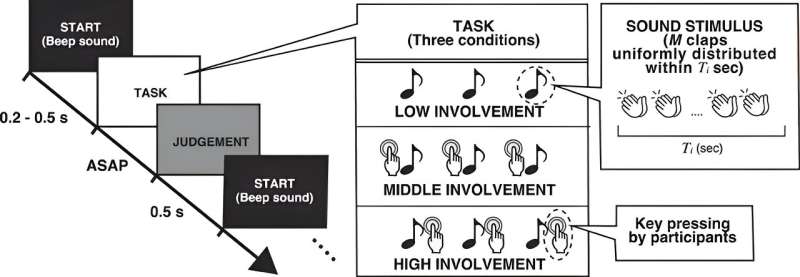Study finds sense of shared simultaneity increases with group size


Researchers from University of Tsukuba have found that the sense of duration of shared simultaneity increases with the size of the group in which an individual participates. This tendency is more pronounced when a person acts more passively within the group. Additionally, the time range for perceiving simultaneity varied flexibly depending on the group size and the nature of interaction.
The information we receive from the external environment reaches the brain at different speeds. For instance, we can perceive the movement of a speaker’s mouth (visual) and their voice (auditory) as occurring simultaneously. This is because the brain integrates information received within a specific period into a single event, a period known as the temporal binding window (TBW).
The researchers explored how TBW is regulated in the collective action of clapping. Participants were presented with artificially generated clapping sounds under various conditions and asked to evaluate their synchrony. The results indicated that TBW expanded logarithmically with an increase in the number of clappers (group size), although the variability of TBW remained unaffected by the group size.
These findings suggest that participants are actively integrating clapping sounds that do not appear precisely simultaneous and interpreting them as simultaneous. Additionally, in the task where participants pressed a key upon hearing the clapping sound—a task involving higher engagement with the group—TBW increased significantly more than that in other tasks with lesser involvement.
This suggests that participants adjust the time range in which they perceive simultaneity based on the undefined interactions within the group. Moreover, the correlation between group size and TBW increase explains the “joint rush,” where participants spontaneously accelerate from the prescribed rhythm to a faster one when attempting to synchronize in a group.
These findings, published in Frontiers in Psychology, are expected to illuminate group-specific dynamics supported by the flexibility of the human sense of time, contributing to our understanding of phenomena such as the groove and sense of unity in music.
More information:
Takayuki Niizato et al, The effect of group size and task involvement on temporal binding window in clap perception, Frontiers in Psychology (2024). DOI: 10.3389/fpsyg.2024.1355586
Citation:
Study finds sense of shared simultaneity increases with group size (2024, May 13)
retrieved 13 May 2024
from https://medicalxpress.com/news/2024-05-simultaneity-group-size.html
This document is subject to copyright. Apart from any fair dealing for the purpose of private study or research, no
part may be reproduced without the written permission. The content is provided for information purposes only.





